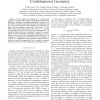Free Online Productivity Tools
i2Speak
i2Symbol
i2OCR
iTex2Img
iWeb2Print
iWeb2Shot
i2Type
iPdf2Split
iPdf2Merge
i2Bopomofo
i2Arabic
i2Style
i2Image
i2PDF
iLatex2Rtf
Sci2ools
ICC
2007
IEEE
2007
IEEE
Multiple-Symbol Differential Detection Based on Combinatorial Geometry
— In this paper, the application of combinatorial geometry to noncoherent multiple–symbol differential detection (MSDD) is considered. The resulting algorithm is referred to as CG–MSDD. Analytical expressions for both the complexity and the error–rate performance of CG–MSDD are derived and it is shown that its complexity is polynomial in the length N of the MSDD observation window if the rank of the N × N channel autocorrelation matrix is fixed, but in fact exponential in N if standard fading models are considered. Compared to popular sphere–decoder based MSDD, CG–MSDD is superior (i) in low– signal–to–noise power ratio (SNR) slow–fading channels as its complexity is independent of the SNR, (ii) as its complexity is constant, i.e., independent of the particular channel and noise realization, and (iii) asymptotically, as its complexity exponent only scales linearly with the bandwidth of the fading process.
Channel Autocorrelation Matrix | Communications | ICC 2007 | MSDD Observation Window | Standard Fading Models |
Related Content
| Added | 02 Jun 2010 |
| Updated | 02 Jun 2010 |
| Type | Conference |
| Year | 2007 |
| Where | ICC |
| Authors | Volker Pauli, Lutz H.-J. Lampe, Robert Schober, Komei Fukuda |
Comments (0)

